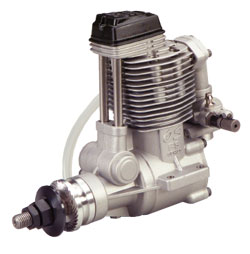The engine was destined for the Great Plains Groovy which I had recently acquired from a club member. The specification for the engine stated use either a 12x8 or 13x7 prop so one of each (APC) was bought and the model tested accordingly.
As you can see from my previous ramblings here, performance was pretty dreadful, there was barely sufficient performance to get the model in the air never mind perform authoritative aerobatics.
An investigation was required.
Tappets
First to check was the tappets. This is very easily done, remove the rocker box cover and using the supplied 0.040mm and 0.10mm feeler gauges, adjust the tappet so that the larger gauge doesn't fit and the smaller one does. To adjust the tappets, release the locknut using the wrench then adjust the gap using a hex Allen key. Hold the tappet screw while retightening the nut when complete or the gap will close up again. This will give you a gap within the recommended range of 0.040 to 0.10mm. The adjustment must be carried out with the engine cold. Simply turn the engine over until one of the valves is fully depressed, then check the other - which will be fully closed. When done turn the engine over again until the second valve is depressed then repeat the process for the remaining valve.The tappets were actually set to 0.040 INCHES, approximately 25 times too big!. These were readjusted and I was convinced that this would have resolved the problem. The fatal flight at NPOD Skelbrooke was the result - the model was still seriously underpowered.
The engine was removed from the model and placed on a test bench and run up. On the 12x8 prop, it was turning over with a peak of about 9000 rpm. This is about 3000rpm down from what OS considers to be typical for this engine/prop combination and explains why power was lacking. It didn't explain what was wrong with the engine though.
In the meantime, I fitted an SC61 to the Groovy which transformed the model, it was now behaving as it should with a sparkling performance on a 11x7 Graupner propeller.
Back to the OS70, It was decided to perform a full strip down and check the valve timing.
Valve Timing
The camshaft sits in that little cylindrical housing in front of the cylinder. This is helically gear driven by a matching gear machined in the crankshaft. Two small cam followers push against the pushrod that are enclosed within the two shiny tubes and these rods operate the valves via the rocker box in the cylinder head.It is clearly important that the valves open and close at the correct time otherwise the engine cannot run optimally. Timing is quite easy to check. Remove the back plate and glow plug, turn the engine to top dead centre - conrod at the top,
remove the camshaft cover (2 screws)
and look for a timing mark on the camshaft. This is a little dot stamped adjacent to a gear tooth. If the mark is not visible, rotate the engine crankshaft one full revolution - the camshaft is geared and will only turn half a revolution. If the timing is correct, then a line that is subtended from the push rod tubes, through the centre of the camshaft should align with the dot, i.e. the dot should be just past bottom towards the front of the engine.
Mine didn't! The photo below with the little dotted red arrow (click on the photo to enlarge), is one tooth out.
The next bench run showed 11500 rpm on a 13x7 prop - much more healthy.
In the meantime, the SC61 had seized (another story), so this engine was placed back into the Groovy and test flown. As you can imagine, the model performed perfectly with ample power for decent vertical manoeuvres.





No comments:
Post a Comment